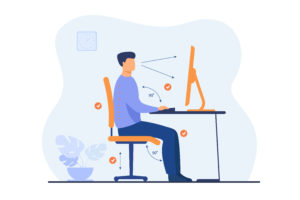
Article by: Kayla Lambert, PT, DPT
Approximately 47% of the population suffers from chronic headaches. Of these individuals, approximately 20% suffer from “cervicogenic headaches,” which is a term used for a type of pain originating in the neck but presenting as headache-type symptoms. Typically, these headaches manifest following a sustained posture or a neck injury such as whiplash. In this new work-from-home culture we have encountered through the COVID-19 pandemic, there has been a significant increase in the prevalence of cervicogenic headaches. This sharp increase in headache prevalence is likely due to the poor ergonomic setup of your home office and therefore increased strain on the cervical spine.
The Anatomy of the Neck Explained:
To better understand the origin of cervicogenic headaches, let’s review a little anatomy of the neck and upper back. First off, you should know that in the medical community, the ‘neck’ is referred to as the ‘cervical spine’ and the middle portion of your back is known as the ‘thoracic spine.’
Place your fingers just behind your ears. Do you feel those hard, bony nodules just behind your earlobes? Follow this bony ridge towards the back of your skull until your fingers meet in the middle. They should meet in a small “valley” between these two bones. Keep your fingers placed in this small indention and nod your head back and forth. Feel that hard, ball-like structure move up and down under your fingers? That is your C2 vertebrae, or the second bone making up the 7 bones in your cervical spine. If you move your fingers down about 2 more inches, you will feel another bony prominence that seems to stick out a little further than the rest. This is your C7, or the last bone making up your cervical spine. Believe it or not, most of the muscles at fault for causing these cervicogenic headaches will fall in this small space between the base of your skull and this C7 bony prominence.
How do Cervicogenic Headaches Differ from Other Types of Headaches?
Cervicogenic headaches often differentiate from alternate types of headache or migraine symptoms based on their location of origin. Most cervicogenic headaches originate at the base of the skull or neck and radiate up into either one or both sides of the head, sometimes forming a “band-like” pain around the forehead and temples. Alternatively, most sinus-related headaches originate either below the eyes or along the forehead, whereas true migraine symptoms typically manifest on one side of the head. These migraines are often accompanied by various other symptoms, such as sensitivity to light, sound, or even nausea and vomiting. Generally, these cervicogenic headaches will become noticeable following prolonged computer use, prolonged reading, or any activity which places your head in a slightly nodded position for an extended period of time.
How Workstations Can Cause Cervicogenic Headaches?
With individuals moving to a work-from-home setting, we have seen a noticeable increase in these cervicogenic headaches. This increase in headache symptoms is likely due to poor ergonomic workstation setup. The most common problems that are often simple fixes include the following:
- Prolonged cervical flexion, or looking down at the computer screen for too long.
- Poor arm support on the keyboard.
- Sitting with the head in a protracted and extended position (pushing the head forward and up for too long).
How Physical Therapy Treats Cervicogenic Headaches?
Since these specific types of headaches are typically a product of increased muscular tension, one of the primary ways to treat these headaches is with conservative physical therapy. Patients will usually see a huge impact in the severity or frequency of these headaches with simple mobility interventions and ergonomic fixes after their first visit. Dry needling is another great tool that we have utilized for these symptoms, showing great relief immediately following this intervention in combination with simple stretching and exercise.
Top 5 Ergonomic Workstation Fixes:

With individuals moving to a work-from-home setting, we have seen a noticeable increase in these cervicogenic headaches. This increase in headache symptoms is likely due to poor ergonomic workstation setup.
- Ensure Your Desktop or Computer Screen is at Eye Level. Even the slightest nod of the head for a prolonged period will likely stress these small muscles to the point of fatigue, and eventually headache.
- Support Your Wrist AND Forearms (as much of the forearm as possible) at a comfortable height near your belly button. Your shoulders should not rise towards your ears when typing.
- Provide Adequate Support to the Arch of Your Lower Spine. This can be something as simple as placing a throw pillow or rolled jacket or towel behind the small of your back. There are plenty of companies that sell “lumbar support pillows” if you are looking to purchase something more official.
- Are Your Feet Touching the Ground? If you are unable to reach the ground due to height restrictions, place a small step stool under your feet to accommodate so you don’t have to worry about lowering your chair to the point where your computer screen is no longer at eye level. You can also use a small trash bin on its side or a few stacked textbooks as a temporary fix.
- Increase the Font or Screen Size to Accommodate Vision. If you feel as if you are having to push your head towards the computer screen to better see the words on the screen, try increasing the font size. If this is a consistent problem, consider making an appointment to see your Optometrist. Sometimes these visual impairments can have a larger impact on the level of headaches experienced than we think.
Page P. Cervicogenic headaches: an evidence-led approach to clinical management. Int J Sports Phys Ther. 2011;6(3):254-266.
Barnes, S., 2021. The Cervical Spine. [online] https://teachmeanatomy.info/neck/bones/cervical-spine/. Available at: <https://teachmeanatomy.info/neck/bones/cervical-spine> [Accessed 13 December 2021].
CC’s Physical Therapy. 2021. Cervicogenic Headaches – CC’s Physical Therapy%| Bismarck, North Dakota. [online] Available at: <https://ccsbismarck.com/cervicogenicheadaches/> [Accessed 13 December 2021].
